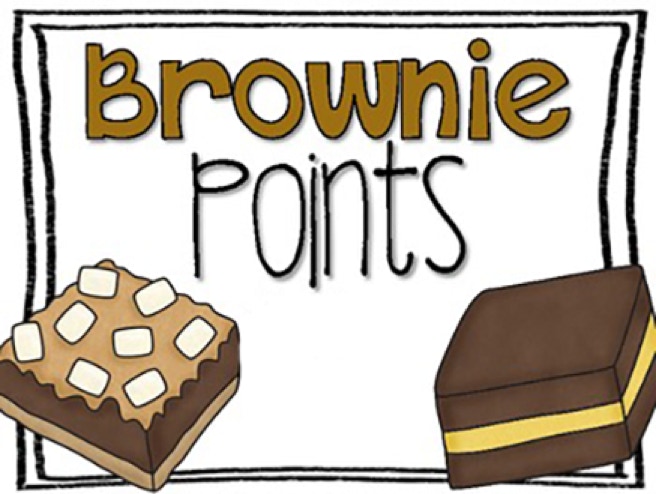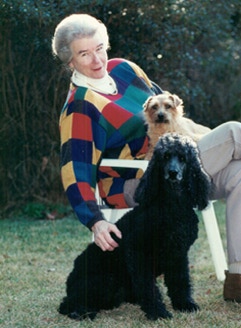UP YOUR DOG SHOW GAME
Helping Breeders &
Exhibitors Succeed in the Show Ring

START BAKING!
HOW TO MAKE

WITH
THE
JUDGE
How to Make
(Legal!)
Brownie Points
with All Judges
By Anne Rogers Clark
Now, how is that for a title? No, I am not going to tell you how to send an upcoming judge Omaha steaks or personal photo of you and your hopeful.
I have judged dogs for a long time and previous to that I started to show our own dogs when I was eight or nine years old. From that beginning, I began to show dogs professionally when I was just out of high school. And all of those years have learned every facet of the sport – I had to!
I feel one of the problems that has occurred in our sport since the advent of more shows, bigger entries and the sport becoming a true family sport, with a place in it for all members of the family - mom, dad as well as the youngsters – is that many of the dogs themselves have not been properly prepared for the rigors of the show ring. Bear in mind that the show ring, as in all livestock, is the place you bring your breeding stock to be evaluated.
There's nothing more frustrating to me as a judge… Wait, may I digress here and explain why I am frustrated with judging? I liken judging to prospecting for gold, or for gemstones. It is the prospect of finding the next great one, or one that will be in an enormous help to the breed, either at stud or in the whelping box. It's to get the feeling of the hairs rising on my arms, and the feeling of discovery that runs through me as an electric current - to look, to get the feeling, then to reassess to make sure that my early warning system has not been activated inaccurately, and the feeling of satisfaction to realize what has spoken to me is a real find and worthy of excitement.
Let's get back to the frustrating part, shall we? Many, many entries are walking into our rings today ill prepared for the rigors of the show ring. Let me list some of the most glaring of problems we judges see today:
1. The exhibition animal is not lead broken.
2. The dog is not properly groomed or trimmed for his breed.
3. The dog is not set up probably in a show pose.
4. The dog will not allow itself to be properly examined.
5. The dog will not let you examine its mouth.
6. A dog’s teeth are heavily coated with tartar and smell to high heaven.
7. The dog has mats in its coat and/or has not been bathed, and smells to heaven.
8. A dog is not be trained to stand on a table.
9. The dog has not been trained to walk up and stand on a ramp.
10. Choke collars are used improperly, or put on backwards.
11. The exhibition dog tries to bit the judge!
12. The person showing the dog is so nervous that he or she forgets everything they been taught to do when entering the show ring, to include not following the judges instructions as to where to set up, what pattern to follow in moving their exhibit, and – one of the most abused judge’s directives – "please do not run with your Chihuahua (or Pom, or Fox Terrier, or Shar-Pei, etc.)”
13. Nails that make the dog look as though it would be happy sleeping on a perch at night (the reverse of this problem are nails that have been cut or filed much too short and look butchered.)
14. Ears that are not clean and sweet-smelling, particularly in dogs with ears that are dropped are hanging – Spaniels, Poodles, Setters, etc.
15. Dogs that are too fat, and those who look as if they need a good square meal.
16. The number of show dogs that need to have the ‘sleepers’ removed from the corners of their eyes previous to coming in the ring is amazing!
17. Learning that the examination animal must be in the proper muscle tone as befits its breed. (This is a huge problem at all-breeds – we have so many shows, and so much traveling, that the opportunity to get out for correct exercising for both man and beast is difficult to come by.)
This list covers the main causes for a judge’s concern.
When a newcomer to our sport buys a show prospect, the least we can do as breeders is to give that person a short course in what dog showing is all about. Should a person be keen and live close by, the short course can be lengthen, and you have been elevated to the position of mentor! Do not skip on your duties, please. If you are unable to take over these responsibilities, do your best to recommend a person in the vicinity of your puppy buyer who can take over some educational duties, or an all-breed club in their area that may run handling classes and/or match shows.
If the puppy will be professionally handled at some point in time, perhaps a designated handler would be available for some educational tips on how to raise a show dog properly. Always be available on the phone to people who get your puppies, be they pets or show dogs, to answer questions honestly and fully to the best of your ability. There are breeding clubs that give classes to help the newcomer to understand the ins and outs and ups and downs of how to properly alert themselves to the intricate sport of dog showing. Scan the Internet - there are many breed clubs that have websites. As time has gone on, I have resorted to giving short handling lessons in the ring, and to be fair, I have given them to those exhibitors with some of the lesser dogs in the ring. Why? Everyone needs to look as good as they possibly can, don't they? I do this as a matter, of course, for I do want the dogs to look as good as they can, in a normal manner. If they could just stand on their own, and be near perfection, that's good enough for me, but I do have to touch them – it's in my job description! Further, I would like to be able to touch them without having to wash my hands, or put bandaids on at the conclusion of the examination.
One of the ways you may wish to try to teach your students to have them watch a particularly outstanding handler or exhibitor of your breed and explain to them what is going on, so that they understand the importance of all the things required for the "in the ring experience." And next step is to video your student attempting to put it all together for you, either in practice or in a real ring appearance. The video gives you a teaching tool that you can share with the student, making suggestions for improvement of technique.
It is an ongoing challenge, but if and when it works, you will be proud to see your breeding, and your student, making brownie points with this judge – as well as with the host of others – by doing their part correctly so that their exhibit may be properly evaluated!
About the author: Although the iconic and revered judge Anne Rogers Clark has been gone nearly two decades, her words of wisdom and experience are still very reverberate in the heart for breeders and exhibitors today. The following is a quote on basic conditioning and training from her “Annie on…Dogs” column.
“As in all of the arts, your finished product must be well-developed, pleasing to the eye, and something of which you are proud to be a part of. Poodles are not, by far, the only breed of dog in which hours of preparation and work play a major role in presentation.
"Ask any good terrier handler and they will tell you - the finished product in the ring is the beauty it is, for more reason than that some unsung master in the art of trimming had spent hours putting every hair in place. A terrier, Poodle, Cocker Spaniel, or any dog is there in all its beauty because there was basically a beautiful animal in the peak of physical and mental form, which had been so conditioned and trained to appear as an outstanding example of that breed. The dog truly is a beautiful ‘work of art.’ No dog can win steadily and consistently unless the dog is basically right to work with - from the inside out. However, having this base, how it is presented, and acts, depends on the amount of time, patience and lastly, ‘know-how’ the person or persons responsible for this dog are willing to give the animal.”
